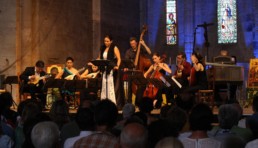ARTEMANDOLINE & NURIA RIAL
Sospiri d’amanti
Arias & Cantatas
An invitation to the intimate setting of an Austrian or Italian Court at the beginning of the XVIIIth century. Contrasting voices and instruments performing as a solo or together will compete with charm and impetuosity to conjure up the vivacity and the beauty of the Italian music at the time. In the early years of the 18th century the mandolin was an integral part of the Baroque musical scene. As such, it is found in a hundred or so operas.
Works by:Caldara, Bononcini, Conti, Händel, Albinoni, Hasse, Gasparini, Paisiello , Galuppi and Mancini.Performers: 9/10 musicians, violins, mandolins, bc & Nuria Rial, soprano.

Between 1690 and 1800, the number of songs for voice and mandolin has been put at between 150 and 200. These are arias from operas, oratorios and cantatas as well as songs that were then in fashion. A number of them have been published, but many others exist only in the form of manuscript copies scattered throughout European libraries. By way of conclusion, we may note that the use of the mandolin in vocal music is an accurate reflection of the aesthetic and historic context of this extraordinarily rich artistic period.
REVIEW
[...] this CD is a jewel of Baroque music. Nuria Rial’s voice perfectly melts with the coloured and sensitive sound of one of the world’s best mandolin baroque ensembles, Artemandoline [...]
Pizzicato Revue, « Supersonic Prize »

